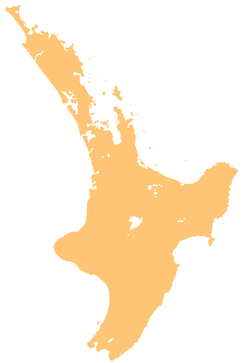Huntly, New Zealand
| Huntly | |
|---|---|
| Minor urban area | |

Waikato River, Huntly and Huntly power station from Hakarimatas in 2012
|
|
| Huntly's location within the North Island | |
| Coordinates: 37°33.5′S 175°9.5′E / 37.5583°S 175.1583°ECoordinates: 37°33.5′S 175°9.5′E / 37.5583°S 175.1583°E | |
| Country | New Zealand |
| Region | Waikato |
| Territorial authority | Waikato District |
| Elevation | 15 m (49 ft) |
| Population (June 2016) | |
| • Total | 7,870 |
| Postcode(s) | 3700 |
Huntly (population 7,067) is a town in the Waikato district and region of the North Island of New Zealand. It is on State Highway 1, 93 kilometres south of Auckland and 35 kilometres north of Hamilton. It is situated on the North Island Main Trunk railway and straddles the Waikato River. It is within the Waikato District which is in the northern part of the Waikato Region local government area.
Huntly was called Rahui Pokeka when migrants settled the town some time in the 1850s. The Huntly name was adopted in the 1870s when the postmaster named it after Huntly, Aberdeenshire in Scotland. He used an old 'Huntley Lodge' stamp to stamp mail from the early European settlement. The 'Lodge' was later dropped and the spelling changed to also drop the additional 'e'.
Huntly Power Station is a large gas/coal-fired power station, prominently situated on the western bank of the Waikato River. It is New Zealand's largest thermal power station, situated in the area which is New Zealand's largest producer of coal, producing over 10,000 tonnes a day. The area has a very long history of coal mining, with both open pit and classical mines operating or having operated here. The major New Zealand clients for the mined coal are the power station and the New Zealand Steel mill at Glenbrook. Huntly is also surrounded by farmland and lakes (many of them former open-pit mines) which are used for coarse fishing, yachting and waterskiing. Kimihia Wetland was created to cope with subsidence and treat water from Huntly East Mine.
Solid Energy closed this last Huntly mine on 22 October 2015, saying it was losing $500,000 a month. It opened in 1978, produced a peak of 465,000 tonnes in 2004 and was digging about 450,000 tonnes a year until production was cut to 100,000 tonnes in September 2013. The mine entrance was in Huntly East, but by 2012 all mining was west of the Waikato, with roadways 150 metres below the river, the two 8 to 20 metre thick sub-bituminous seams being 150 to 400 metres deep. In 2012 it was estimated that 7 million tonnes of recoverable coal remained in the consented mining areas, with a further 12 million available for future expansion. Coal was mined by remote-controlled continuous miners and taken to the entrance in shuttle cars and then by conveyor belt. It continued to Glenbrook via the Kimihia branch railway and the NIMT. It employed about 200 in 2012, but was down to 68 at closure.
...
Wikipedia

